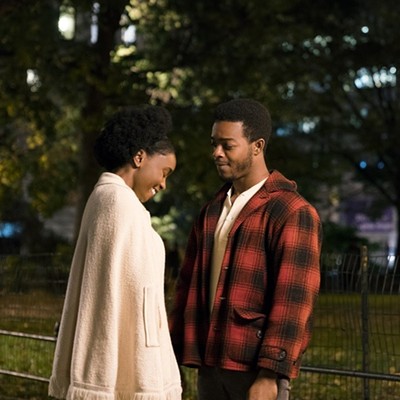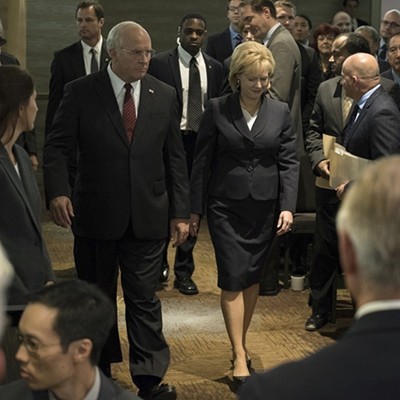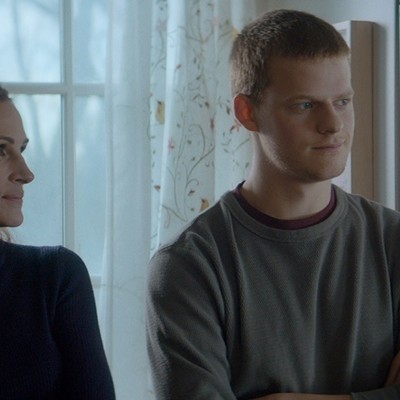Don’t expect Amir Bar-Lev’s Long Strange Trip, a sweeping if not very penetrating look at the 30-year career of the Grateful Dead, to offer major revelations. For any Deadhead — and it’s hard to imagine any other kind of viewer settling in for the four-hour running time — the basic outlines of the band’s history will be familiar.
But if the story is known, the telling is here lusher than any before, the film stuffed with rare archival footage and performance clips. The effect is one of coasting along amid a vast, noisy, variegated parade, vividly rendered. And that works just fine.
Bar-Lev takes us through Jerry Garcia’s early days as a bluegrass plucker and coffeehouse folk bard, through the band’s time gigging at Ken Kesey’s acid tests, on to its explosive commercial growth in the 1980s and ’90s, as the Dead become a stadium-filling colossus. Sections on the late 1960s and early ’70s bring us inside the anarchic Bay Area scene that had begun to take a darker turn in the twilight of the hippie era. We meet Owsley Stanley, the legendary LSD chemist, who cranked out millions of doses of the drug and turned on a generation, even as he devised the band’s groundbreakingly massive sound system. We see armed, brawling Hells Angels mingle with flower children in the Dead’s entourage, sometimes uneasily.
Bar-Lev renders it all immersively, without shying away from the ugly parts. Early clips of an impossibly young and clean-cut Garcia, clowning with the band’s longtime lyricist, Robert Hunter, on a cross-country road trip, are alone worth the time.
By the later years, the film’s focus shifts to the chaos of the Deadhead tour scene, in which hordes of (mostly white, mostly middle-class) kids go looking for something different in Reagan-era America. Garcia seems to understand the impulse.
“I think now, during the ’80s,” he says in a vintage interview, “the Grateful Dead represents something like hopping railroads. You know what I mean? Something like that, or being on the road, like Kerouac. You can’t do those types of things anymore, but you can be a Deadhead and get in your van and go with the other Deadheads across the United States. And that looks like fun, you know?”
Thankfully, we’re not asked to endure four hours of the band members themselves, perched on stools, recounting what they’ve recounted so many times before. Much of the narrative is told through roadies and sound guys and tour managers in recent interviews, characters one degree outside the inner circle.
It’s refreshing, but there are moments when that approach begins to feel tepid. When Ron “Pigpen” McKernan, the gunslinging, whiskey-addled bluesman who provided the Dead most of its propulsive muscle in the early years, drinks himself to death at 27, we hear little from the band members themselves. Other pivotal moments like this also are less than fully explored.
Bar-Lev organizes the film’s thesis, and sets up the final hour, around an artistic metaphor drawn from statements Garcia made about the Watts Towers, Sabato Rodia’s sprawling, improvised work of outsider art in Los Angeles that turned out to be too sturdy for the city to tear down. Now it’s a landmark. Garcia, too, was looking to create something ephemeral, but the Dead proved far more enduring than he ever expected. In interviews, Garcia says that what they were running by the early 1990s had long ceased to be the breezy mobile party of the early days. It was instead a sprawling business empire as much as an act, one around which thousands of lives revolved and upon which hundreds of livelihoods depended. Just as confining for Garcia was the worshipful fan base, which had come to view him — in some cases literally — as a kind of prophet. He had become a reluctant authority figure, ironic and disorienting for a guy who loathed authority of any kind. (Garcia was a marginally active libertarian in later years.)
By late in the film, it’s long past time for Garcia to take a break, but he can’t. He reacts by smoking heroin and neglecting his health. The closing section, a study of Garcia’s entrapment within the thing he made, and his eventual death, in 1995, brings Bar-Lev’s thesis together. It’s far more intimate than the earlier passages, relying on interviews with Garcia’s late-life partner, Brigid Meier, and his daughter, Trixie.
It should go without saying, given its eye-popping length, that this is primarily a movie for Deadheads. But if the uninitiated somehow wander into the theater, they might find something to challenge preconceived notions. The soundtrack is appropriately stocked with gems and encompasses the Dead’s wildly divergent styles; heavily improvisational psychedelia mingles with tight, percussive, country- and bluegrass-adjacent Americana. If you’ve heard only limited selections, the range might surprise you.
There’s also an insightful look at Robert Hunter’s songwriting — which often drew on themes of death, sin and regret — that might disabuse some false notions about the band’s aesthetic. As New Yorker staff writer Nick Paumgarten puts it, Garcia’s popular image was as a “big, happy hippie icon,” and the Dead are sometimes seen in that light: more sunshine and bare feet than cold rain and snow. But that was never really accurate.
“You get to know, if you listen to the music, that actually he’s a deliverer of dark news,” Paumgarten says of Garcia. “And that’s when you really begin to take him seriously.”
Support Us
Houston's independent source of
local news and culture
account
- Welcome,
Insider - Login
- My Account
- My Newsletters
- Contribute
- Contact Us
- Sign out
That Four-Hour Grateful Dead Doc Invites You to Melt into the Dream
Jon Campbell May 19, 2017 2:00PM

This is going to go on for a while.
Peter Simon. Courtesy Amazon Prime Video.
[
{
"name": "Related Stories / Support Us Combo",
"component": "11591218",
"insertPoint": "4",
"requiredCountToDisplay": "4"
},{
"name": "Air - Billboard - Inline Content",
"component": "11591214",
"insertPoint": "2/3",
"requiredCountToDisplay": "7"
},{
"name": "R1 - Beta - Mobile Only",
"component": "12287027",
"insertPoint": "8",
"requiredCountToDisplay": "8"
},{
"name": "Air - MediumRectangle - Inline Content - Mobile Display Size 2",
"component": "11591215",
"insertPoint": "12",
"requiredCountToDisplay": "12"
},{
"name": "Air - MediumRectangle - Inline Content - Mobile Display Size 2",
"component": "11591215",
"insertPoint": "4th",
"startingPoint": "16",
"requiredCountToDisplay": "12"
}
,{
"name": "RevContent - In Article",
"component": "12527128",
"insertPoint": "3/5",
"requiredCountToDisplay": "5"
}
]
KEEP THE HOUSTON PRESS FREE...
Since we started the Houston Press, it has been defined as the free, independent voice of Houston, and we'd like to keep it that way. With local media under siege, it's more important than ever for us to rally support behind funding our local journalism. You can help by participating in our "I Support" program, allowing us to keep offering readers access to our incisive coverage of local news, food and culture with no paywalls.
Trending Film
- International Film Festival 2000
- It’s Sadly Kind of Perfect That New Season of GLOW Is Stolen by Marc Maron
- Jonah Hill’s Mid90s Takes an Honest Plunge Into the Millennial Past
-
Sponsored Content From: [%sponsoredBy%]
[%title%]

Don't Miss Out
SIGN UP for the latest
news, free stuff and more!
Become a member to support the independent voice of Houston
and help keep the future of the Houston Press FREE
Use of this website constitutes acceptance of our
terms of use,
our cookies policy, and our
privacy policy
The Houston Press may earn a portion of sales from products & services purchased through links on our site from our
affiliate partners.
©2024
Houston Press, LP. All rights reserved.




